4 Figure Painting Artists You Need to Know

Alex Bostic, Helen Bouchard, Margaret Dyer, and Emiliya Lane are each uniquely talented in the timeless art of figure painting.
By Allison Malafronte

Memory Lane (oil, 30 х 30) by Emiliya Lane
For as long as artists have been drawing and painting, the figure has been a central subject. In classical academies and ateliers, students spend years painting live models, using sight-size or other measuring methods to learn anatomy, structure, and form. Illustrators and animators sketch the figure daily to develop characters and convey action and expression. Even multidisciplinary modern schools often require students to take figure-drawing classes to keep their skills sharp.
The four figure painting artists featured in this portfolio have all benefited from one or more of these figurative approaches. They have also developed their own painting styles based on additional education and personal preferences. Bringing years of professional accomplishments and teaching credentials to the table, Alex Bostic, Helen Bouchard, Margaret Dyer, and Emiliya Lane are each uniquely qualified to speak to the timeless art of figure painting.
Alex Bostic

Sys Sleeping (oil, 29 x 39) by Alex Bostic
Alex Bostic grew up in Brooklyn, NY, received his Bachelor of Fine Arts degree in illustration from Pratt Institute, and spent 40 years as a professional illustrator before turning his attention to portrait and figure painting. Working in a variety of drawing and painting media, Bostic now paints subjects of his own choosing imbued with the powerful narrative qualities of his illustration work.

David (oil, 18 x 18) by Alex Bostic 
Milayla (casein, 9 x 14) by Alex Bostic
Portraying the African American Experience
Bostic had several former illustrator friends who helped him navigate the transition from commercial to fine art. During this time, he became fascinated with painting figures and portraits. He decided to focus on portraying the African American experience, which he felt was missing from the field. “I noticed that a lot of professional portraits and figure paintings were of aristocrats and the wealthy; I wanted to paint people of color who would otherwise not have the opportunity, to enhance and elevate their status.”
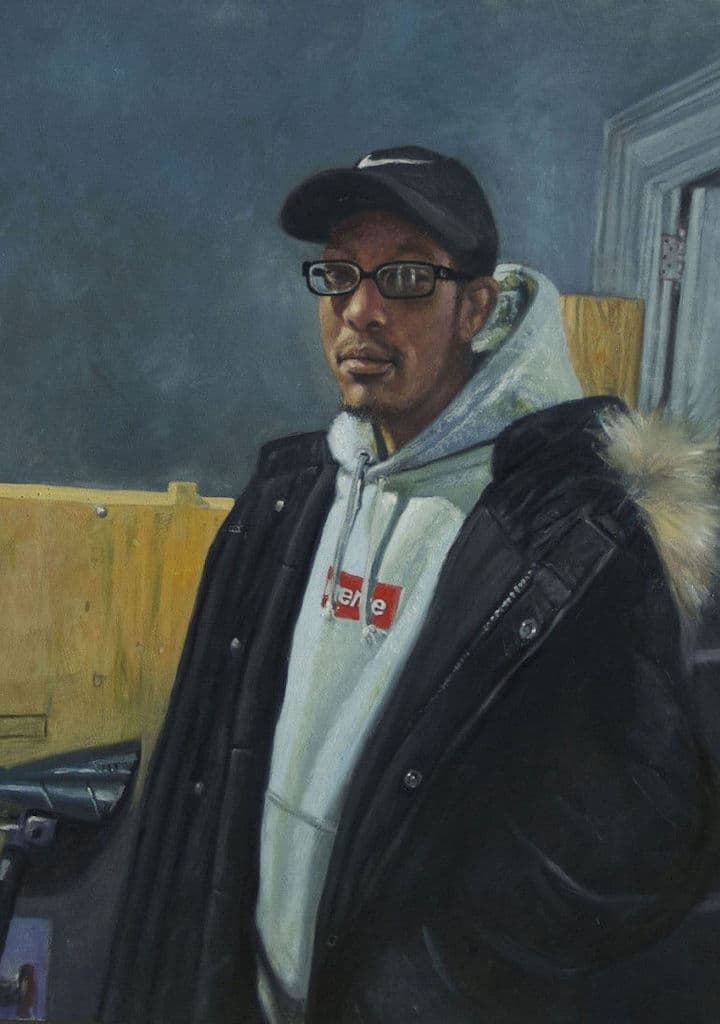
Dupree (oil, 40 x 30) by Alex Bostic 
The Aviator (oil, 18 x 18) by Alex Bostic
Personal Stories
The figure painting artist turned to friends, family, and acquaintances as his subjects, bringing their personal stories and perspectives to light on canvas. The painting Dupree, for example, captures a time when his son was transitioning to a new career in advertising. “I drove him to New York City for his internship at an ad agency. Then we visited the studios of some artists I know,” Bostic recalls. “I took pictures of him interviewing one of my friends. I was really proud of him in this moment and wanted to paint it because it symbolized the beginning of the rest of his life and career.”
Today Bostic does both illustration and fine-art paintings. When he was writing a paper about artists with such dual careers while earning his master’s degree at Syracuse University, Bostic learned a valuable lesson: “Never change your style. The way you paint commercially is the way you paint in fine art.” To learn more, visit alexbostic.com.
Helen Bouchard

A Quiet Moment (oil, 20 x 24) by Helen Bouchard
At the young age of 17, figure painting artist Helen Bouchard found her creative calling and the style she would pursue for years to come on a high-school trip to Florence, Italy. Suddenly in the epicenter of Renaissance art and architecture, the young artist stared with wide-eyed amazement at Old Master paintings on the walls of local churches, masterpieces at the Pitti Palace and Uffizi Gallery, and ancient sculpture and architecture around seemingly every corner.

Equanimity (oil, 36 x 24) by Helen Bouchard 
Tuscan Kitchen (oil, 20 x 16) by Helen Bouchard
Can’t Escape Florence
With that formative experience firmly planted in her mind, Bouchard returned home and made her way to the Gage Academy of Art in Seattle. Its classical-realist curriculum is centered on learning how to draw and paint the figure by first learning how to accurately see form. Students progress through a series of techniques including Bargue drawings (direct copies of lithographs created by 19th-century French artist Charles Bargue), cast drawings, painting in grisaille, and finally painting the full figure with a limited palette. While a student at the academy, Bouchard won a summer scholarship to the Florence Academy of Art and was able to visit Italy once more.
Now making her home and studio in picturesque Oregon, Bouchard finds her Florentine experiences and figurative education still informing her work. “That training is the single best thing I could have done to improve my understanding and skills,” the artist says. “Not only did we learn how to draw and paint the figure from life but we also learned the discipline needed to become a professional artist and put in the time every day.”
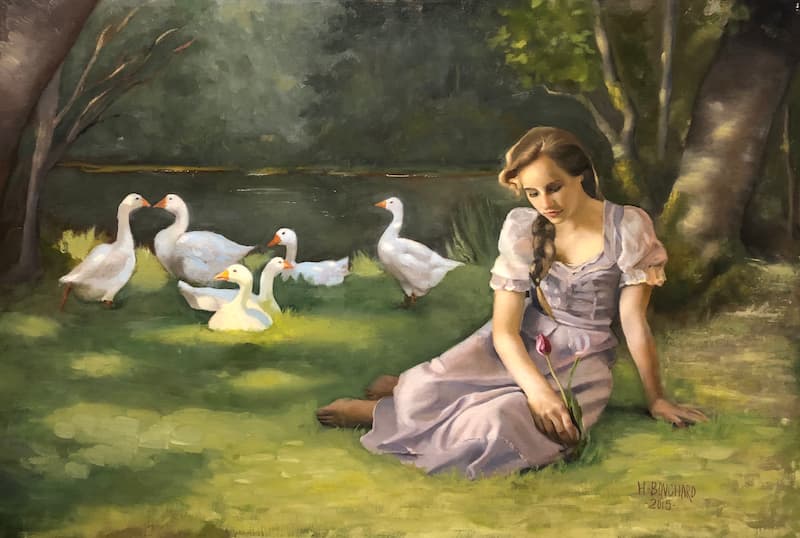
Girl With Geese (oil, 24 x 36) by Helen Bouchard 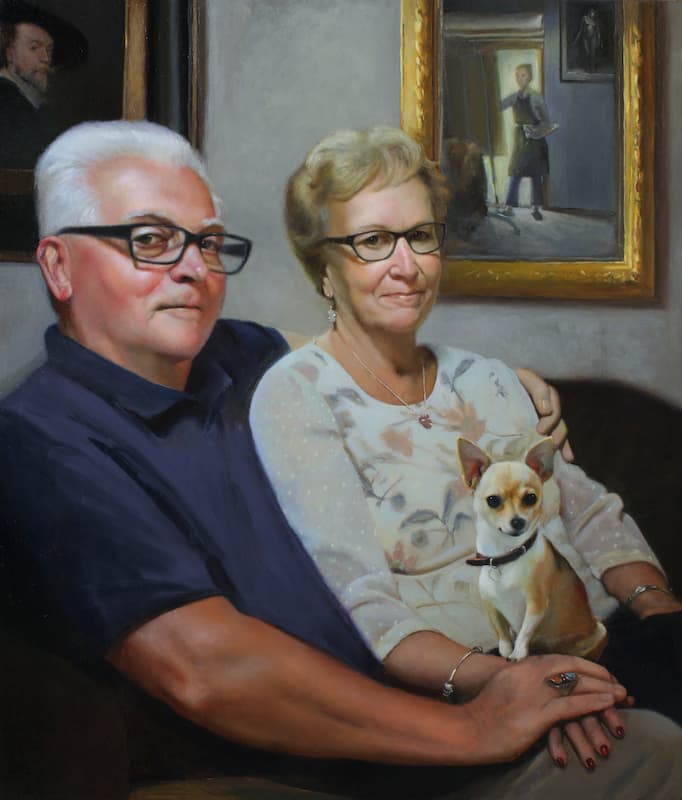
Pillars (oil, 24 x 20) by Helen Bouchard
Journal Entries
Although she now paints a range of subjects, Bouchard frequently returns to the figure. “It’s a wonderful way to communicate the human experience in a language people understand,” she says. “I love learning about people’s stories. I’ve been an avid journaler all my life, and paintings are like journal entries to me. They are records of my life experiences and the people I meet.” To learn more, visit hlbouchard.com.
Margaret Dyer

First Day at the Beach (pastel, 18 x 24) by Margaret Dyer
The figure has been Margaret Dyer’s passion since her first life-drawing class at the Atlanta College of Art in 1970. “At that moment, I found something I loved — the challenge of drawing the living, breathing, continuously moving landscape of the human body,” she says. Ten years after that class, Dyer discovered her preferred medium when she first saw the work of artist Kate Fetterolf. She was amazed at how beautiful pastel paintings could be. Dyer studied with Fetterolf weekly for five years.

Kristin at the Piano (oil, 14 x 11) by Margaret Dyer 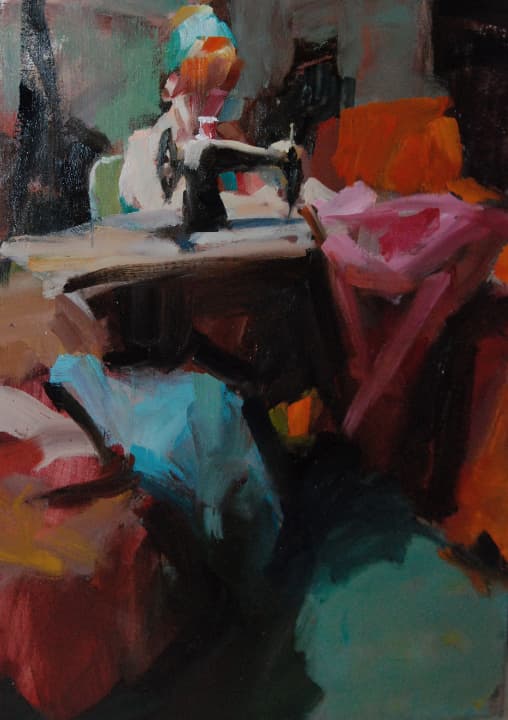
The Seamstress (oil, 20 x 16) by Margaret Dyer
Layers of Lush Color
Over the next decade, while developing a national reputation as an accomplished pastelist, Dyer dabbled in oils. But she admits to struggling with the medium at first. Five years ago, however, she put down her pastels to devote to her undivided attention and further education to oil painting until it clicked. She now goes between the two media to create her award-winning figurative works. In fact, her oil and pastel paintings are often indistinguishable; they share the same strong use of line, layers of lush color, and painterly, light-filled quality.
Although her process varies with each medium, Dyer’s approach to color is consistent. “I was taught, when I first started working in pastel, that as long as the value is correct, the color can be anything,” she says. “This is still how I paint and teach. In both oil and pastel paintings, I layer color upon color — even sometimes seemingly clashing colors — in the same value until I get the visual vibration I’m after.”
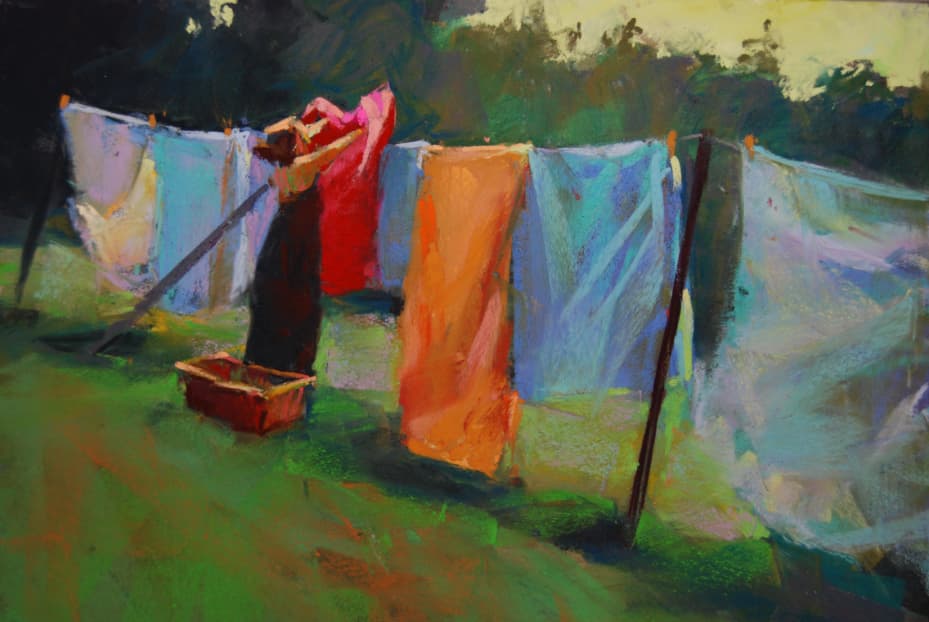
Laundry Day (pastel, 18 x 24) by Margaret Dyer 
Dancer Alone (oil, 16 x 20) by Margaret Dyer
A Visual Thrill
These vibrant results can be seen in all of Dyer’s paintings, including the pastel titled First Day at the Beach and the oil painting The Seamstress; the latter won Best of Show in the American Impressionist Society’s Associate Members Online Exhibition earlier this year. “All these years later, I feel the same way I felt in that figure-drawing class in college. It’s still that thrilling to me,” Dyer says. To learn more, visit margaretdyer.blogspot.com and patreon.com/margaretdyer.
Emiliya Lane
Emiliya Lane is a Russian figure painting artist who has been living in America for more than 20 years and who has built an extensive résumé. Many artists discover a love of drawing at a young age but don’t pursue it seriously until they’re much older. Lane, on the other hand, was enrolled in an art school from the ages of 6 through 16 and had the advantage of an intense, integrated arts education throughout her youth, as is typical in many culturally rich cities in Russia.

Red Chair (oil, 16 x 12) by Emiliya Lane 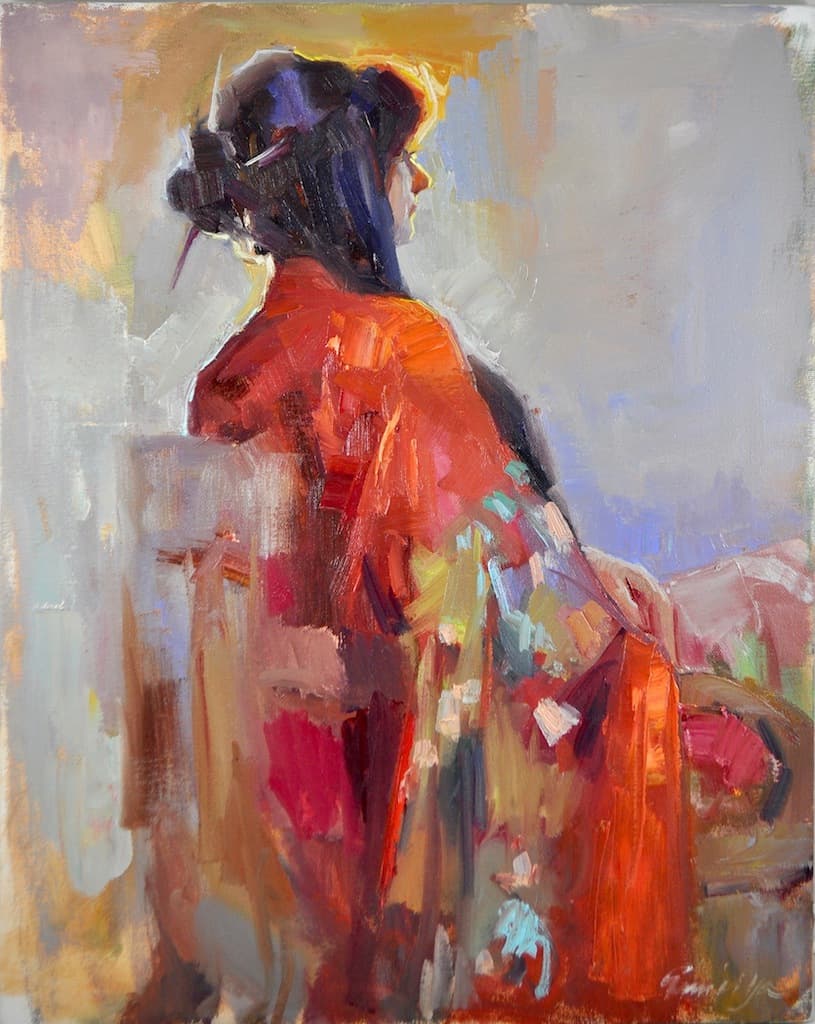
Old Kimono (oil, 20 x 16) by Emiliya Lane
An Animated History
Straight out of high school, Lane worked as an animator and illustrator at a film studio while simultaneously attending Ural State University in Ekaterinburg. She developed her figure-drawing skills through the continuous sketching required in traditional animation while learning about art history, literature, and language at college. After 15 years in commercial art, and with a master’s degree in fine art and art history to her credit, she immigrated to the United States with her American husband. Once settled in Seattle, she began working at a contemporary art gallery while pursuing studies with several top American artists.
Her first figure-drawing workshop in the U.S. with Robert Liberace was a game-changer. “I had always wanted to study with him because of his astounding knowledge of figure, character, and anatomy,” Lane says. “After this, the face and figure became a stronger focus in my work.” Additional workshops with such artists as Ovanes Berberian (who was himself a student of Russian master Sergei Bongart), Zhaoming Wu, Jeremy Lipking, and Daniel Gerhartz taught her the art of alla prima painting.

The Ring (oil, 20 x 20) by Emiliya Lane 
Midnight Bride (oil, 20 x 20) by Emiliya Lane
Energy and Excitement
For Lane, painting the figure is all about conveying emotion, and she does this primarily through color. “I consider my style Russian Impressionism, and in the classes I teach everything is about learning how to see, color mixing, color temperature, and paint application,” she says. “With the figure, there are a lot of abstract qualities, and I’m most concerned with shapes and how shapes can depict that amazing energy and excitement that occurs when painting a human being.” To learn more, visit artlanegallery.com, saatchiart.com, and artfinder.com.
A version of this article originally appeared on SouthwestArt.com.



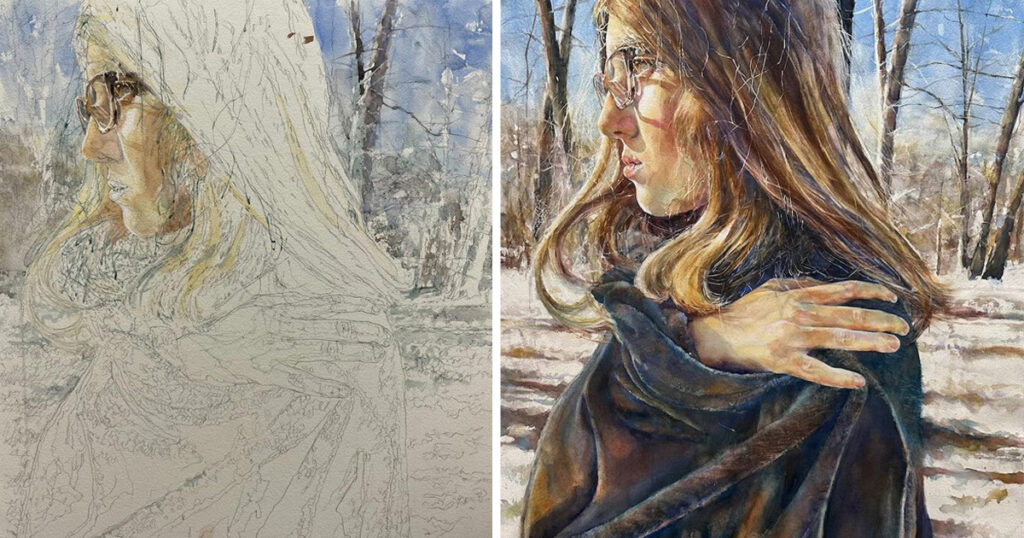

Have a technical question?
Contact UsJoin the Conversation!